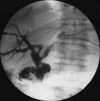Transhepatic metallic stenting for hepaticojejunostomy stricture following laparoscopic cholecystectomy biliary injury: A case of successful 20 years follow-up
- PMID: 22837599
- PMCID: PMC3401726
- DOI: 10.4103/0972-9941.97599
Transhepatic metallic stenting for hepaticojejunostomy stricture following laparoscopic cholecystectomy biliary injury: A case of successful 20 years follow-up
Abstract
Laparoscopic cholecystectomy is still associated with a considerable rate of biliary injuries and related strictures. Advances in interventional endoscopy and percutaneous techniques have made stenting a preferred treatment modality for the management of these strictures. We report successful 20 years of follow-up of a case of trans-hepatic metallic stenting (2 Gianturco(®) prostheses, 5 cm long, 2 cm in diameter) done for stenosed hepatico-jejunostomy anastomosis after laparoscopic CBD injury. Percutaneous transhepatic stenting and long-term placement of metallic stents need to be re-evaluated as a minimally invasive definitive treatment option for benign biliary strictures in patients with altered anatomy such as hepatico-jejunostomy or in whom re-operation involves high risk.
Keywords: Biliary SEMS; hepatico-jejunostomy stricture; iatrogenic bile duct injuries; metallic biliary stents; percutaneous transhepatic biliary stenting; postoperative biliary strictures.
Conflict of interest statement
Figures


Similar articles
-
Postoperative bile duct strictures: management and outcome in the 1990s.Ann Surg. 2000 Sep;232(3):430-41. doi: 10.1097/00000658-200009000-00015. Ann Surg. 2000. PMID: 10973393 Free PMC article.
-
Placement of metallic stents for treatment of postoperative biliary strictures: long-term outcome in 25 patients.AJR Am J Roentgenol. 1997 Dec;169(6):1517-22. doi: 10.2214/ajr.169.6.9393155. AJR Am J Roentgenol. 1997. PMID: 9393155
-
Long-term follow-up of percutaneous transhepatic therapy (PTT) in patients with definite benign anastomotic strictures after hepaticojejunostomy.Endoscopy. 2001 May;33(5):409-15. doi: 10.1055/s-2001-14264. Endoscopy. 2001. PMID: 11396758 Clinical Trial.
-
Current management of benign bile duct strictures.Adv Surg. 1992;25:119-74. Adv Surg. 1992. PMID: 1536094 Review.
-
Postoperative bile duct strictures.Surg Clin North Am. 1990 Dec;70(6):1355-80. doi: 10.1016/s0039-6109(16)45289-8. Surg Clin North Am. 1990. PMID: 2247820 Review.
Cited by
-
Bile Duct Injuries after Cholecystectomy: An Individual Patient Data Systematic Review.J Clin Med. 2024 Aug 16;13(16):4837. doi: 10.3390/jcm13164837. J Clin Med. 2024. PMID: 39200979 Free PMC article. Review.
References
-
- Vecchio R, MacFadyen BV, Latteri S. Laparoscopic cholecystectomy: An analysis on 114,005 cases of United States series. Int Surg. 1998;83:215–9. - PubMed
-
- Costamagna G, Shah SK, Tringali A. Current management of postoperative complications and benign biliary strictures. Gastrointest Endosc Clin N Am. 2003;13:635–48. 9. - PubMed
-
- Isayama H, Nakai Y, Togawa O, Kogure H, Ito Y, Sasaki T, et al. Covered metallic stents in the management of malignant and benign pancreatobiliary strictures. J Hepatobiliary Pancreat Surg. 2009;16:624–7. - PubMed
-
- Misra S, Melton GB, Geschwind JF, Venbrux AC, Cameron JL, Lillemoe KD. Percutaneous management of bile duct strictures and injuries associated with laparoscopic cholecystectomy: A decade of experience. J Am Coll Surg. 2004;198:218–26. - PubMed
Publication types
LinkOut - more resources
Full Text Sources
